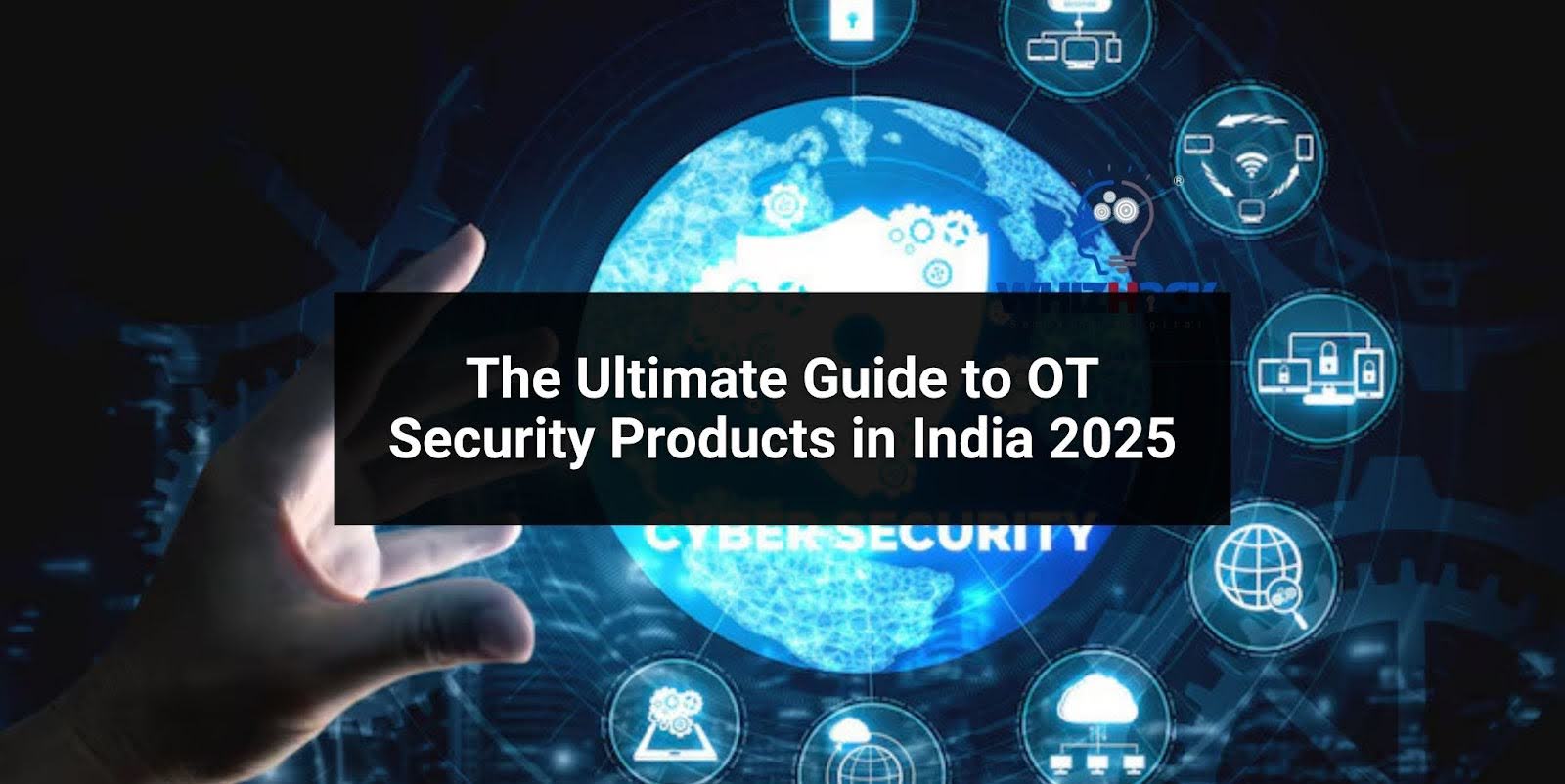In India’s rapidly digitising industrial landscape, Operational Technology (OT) security has become a cornerstone of protecting critical infrastructure. This blog post discusses the multiple advantages of using an integrated cybersecurity solution, as well as its effectiveness in combating changing cyber threats.
Introduction
In India’s rapidly digitising industrial landscape, Operational Technology (OT) security has become a cornerstone of protecting critical infrastructure. From manufacturing plants to smart cities, OT systems—comprising industrial control systems (ICS), SCADA, and IIoT devices—drive efficiency but face growing cyber threats. Ransomware attacks, data breaches, and nation-state hacking have exposed vulnerabilities in OT environments, making robust security products essential.
This 2025 guide explores OT security products in India, offering insights into solutions, vendors, industry applications, and strategies to safeguard your operations. Whether you’re an IT manager, industrial engineer, or procurement specialist, this resource will help you navigate the complex world of OT cybersecurity in India.
India’s push toward Industry 4.0, coupled with initiatives like Digital India, has accelerated OT adoption. However, a 2024 Gartner report highlighted that 70% of Indian industrial firms lack adequate OT security, increasing risks to critical sectors like power and oil. Local innovators like WhizHack Technologies are addressing these challenges with AI-driven solutions like ZeroHack OT, complementing global leaders. This guide covers everything from market trends to vendor comparisons, addressing questions like “What are OT security products?” and “How do I choose the right solution for my industry?” Let’s dive into the ultimate resource for securing India’s industrial future.
What is OT Security?
Defining OT Security
Operational Technology (OT) security refers to the protection of hardware and software that monitor and control physical processes in industries like manufacturing, energy, and utilities. Unlike Information Technology (IT) systems, which manage data, OT systems manage physical operations—think robotic arms in factories or turbines in power plants. OT security products, such as WhizHack’s ZeroHack OT, safeguard these systems from cyber threats, ensuring operational continuity and safety.
OT vs. IT Security
While IT security focuses on data confidentiality, OT security prioritises availability and safety. A breach in OT systems can halt production, damage equipment, or endanger lives. Key differences include:
- Environment: OT systems often use legacy protocols (e.g., Modbus, OPC) and operate in harsh industrial settings.
- Priorities: OT emphasises uptime, while IT prioritises data integrity.
- Threat Impact: OT breaches can cause physical harm, unlike most IT breaches.
Key Components of OT Security
OT security products encompass tools and strategies to protect ICS, SCADA, and IIoT devices. Core components include:
- Network Security: Firewalls and intrusion detection systems (IDS) to monitor OT networks.
- Endpoint Protection: Software to secure devices like PLCs (Programmable Logic Controllers).
- Threat Detection: Solutions like WhizHack’s TRACE to identify anomalies and malware in real time.
- Access Control: Authentication mechanisms to restrict unauthorised access.
Understanding these components is crucial for selecting the right OT security products in India, where industrial digitisation is surging.
Why OT Security Matters in India
Industrial Growth and Digitisation
India’s industrial sector is booming, with a projected $1 trillion manufacturing economy by 2030 (NITI Aayog). The adoption of IIoT, smart factories, and 5G has transformed industries, but it’s also expanded the attack surface. A 2024 IDC report noted that 60% of Indian manufacturers use IIoT devices, yet only 25% have robust OT security.
Rising Cyber Threats
Cyberattacks on OT systems are escalating. The 2023 ransomware attack on a major Indian oil refinery disrupted operations for weeks, costing millions. Nation-state actors and cybercriminals target critical infrastructure, exploiting vulnerabilities in legacy systems. Common threats include:
- Ransomware: Locks OT systems, demanding payment.
- Phishing: Targets employees to gain network access.
- DDoS Attacks: Overwhelm OT networks, causing downtime.
Regulatory Landscape
India’s government is tightening cybersecurity regulations. The CERT-In guidelines (2022) mandate incident reporting and security audits for critical infrastructure. The National Cybersecurity Policy (2023) emphasises OT security for sectors like power and transportation. Non-compliance can lead to fines and reputational damage, making OT security products a priority.
Economic and Safety Impacts
A breach in OT systems can halt production, disrupt supply chains, and cause environmental hazards. For example, a compromised power grid could blackout entire cities. Investing in OT security, including solutions from WhizHack Technologies, protects India’s economic growth and public safety.
Market Overview: OT Security in India
Market Size and Growth
The OT security market in India is growing rapidly. A 2024 MarketsandMarkets report projects the Indian OT cybersecurity market to reach $1.2 billion by 2028, with a CAGR of 18%. Key drivers include:
- Industry 4.0: Adoption of smart manufacturing and IIoT.
- Government Initiatives: Digital India and Make in India promote industrial digitisation.
- Cyber Threat Awareness: High-profile attacks have spurred investment.
Key Players
Global and local vendors dominate the market. Global leaders like Cisco, Fortinet, and Palo Alto Networks offer advanced OT security solutions, while Indian firms like WhizHack Technologies, Seqrite, and TAC Security cater to cost-sensitive buyers with innovative, India-centric solutions. WhizHack’s AI-driven ZeroHack OT and TRACE platforms are gaining traction for critical infrastructure protection. The market is competitive, with vendors focusing on AI-driven threat detection and zero-trust architectures.
Regional Trends
Southern India (Bengaluru, Chennai) leads in OT security adoption due to its manufacturing hubs. Western India (Mumbai, Gujarat) follows, driven by the oil and gas industries. Northern India is catching up, with smart city projects in Delhi-NCR boosting demand.
Challenges
Despite growth, the market faces hurdles:
- Legacy Systems: Many Indian firms use outdated OT equipment, complicating security.
- Skill Shortages: Lack of trained OT security professionals.
- Cost Sensitivity: SMEs struggle with high implementation costs.
Understanding these trends helps businesses navigate the OT security landscape in India.
Types of OT Security Products
Network Security Solutions
Network security is the backbone of OT protection. Products include:
- Firewalls: Next-generation firewalls (NGFWs) like Fortinet FortiGate filter OT network traffic, supporting protocols like Modbus and OPC.
- Intrusion Detection/Prevention Systems (IDS/IPS): Tools like WhizHack’s TRACE detect and block unauthorised activity in real time.
- Network Segmentation Tools: Cisco Cyber Vision isolates OT and IT networks, reducing attack surfaces.
Endpoint Security
Endpoint protection secures devices like PLCs and HMIs (Human-Machine Interfaces). Solutions include:
- Antivirus Software: Kaspersky Industrial Cybersecurity protects endpoints from malware.
- Device Hardening Tools: Claroty Platform locks down configurations to prevent tampering.
- Patch Management: WhizHack’s ZeroHack OT automates updates for OT devices.
Threat Detection and Response
These products identify and mitigate threats:
- Anomaly Detection: Nozomi Networks uses AI to spot unusual behaviour in OT networks.
- Security Information and Event Management (SIEM): Splunk Enterprise correlates OT and IT logs for threat analysis.
- Incident Response Tools: Palo Alto Networks Cortex XDR automates response to OT breaches.
Access Control and Authentication
Restricting access is critical for OT security:
- Identity and Access Management (IAM): Okta provides multi-factor authentication (MFA) for OT systems.
- Privileged Access Management (PAM): CyberArk secures admin accounts.
- Remote Access Solutions: BeyondTrust enables secure remote maintenance of OT assets.
Data Protection
Protecting OT data ensures operational integrity:
- Encryption Tools: Thales CipherTrust encrypts sensitive OT data.
- Data Loss Prevention (DLP): Symantec DLP prevents unauthorised data transfers.
- Backup Solutions: Veeam ensures data recovery post-breach.
Each product type addresses specific OT vulnerabilities, making a layered approach essential.
Top OT Security Vendors in India
Global Vendors
-
Cisco:
- Product: Cisco Cyber Vision
- Features: Real-time asset discovery, anomaly detection, network segmentation.
- Use Case: Smart grids in India’s power sector.
- Pros: Scalable, integrates with IT security.
- Cons: High cost for SMEs.
-
Fortinet:
- Product: FortiGate NGFW
- Features: Deep packet inspection, OT protocol support, zero-trust.
- Use Case: Oil refineries in Gujarat.
- Pros: Robust support, cost-effective for mid-sized firms.
- Cons: Complex setup.
-
Palo Alto Networks:
- Product: Cortex XDR
- Features: AI-driven threat detection, endpoint protection.
- Use Case: Manufacturing plants in Chennai.
- Pros: Comprehensive, cloud-native.
- Cons: Steep learning curve.
Local Vendors
-
- Product: ZeroHack OT
- Features: AI-driven threat detection, honeynet sensors mimicking OT assets, deep packet inspection, and compliance with CERT-In standards. Includes TRACE for real-time SCADA protection and N-OT for network intrusion detection.
- Use Case: Power grids and oil refineries in India, with deployments in critical infrastructure.
- Pros: Affordable, India-centric, strong local support through partnerships with IIT Jodhpur and NPTI. Awarded at DSCI FINSEC Conclave 2024 for innovation.
- Cons: Limited global presence compared to Cisco or Palo Alto.
-
Seqrite:
- Product: Seqrite Endpoint Security
- Features: Malware protection, OT device monitoring.
- Use Case: SMEs in manufacturing.
- Pros: Affordable, local support.
- Cons: Limited advanced features.
-
TAC Security:
- Product: ESOF Platform
- Features: Vulnerability management, compliance reporting.
- Use Case: Smart cities in Delhi-NCR.
- Pros: Tailored for Indian regulations.
- Cons: Smaller global presence.
Comparison Table
| Vendor | Key Product | Best For | Price Range | Support Quality |
|---|---|---|---|---|
| Cisco | Cyber Vision | Large enterprises | High | Excellent |
| Fortinet | FortiGate | Mid-sized firms | Medium | Good |
| Palo Alto Networks | Cortex XDR | High-tech industries | High | Excellent |
| Seqrite | Endpoint Security | SMEs | Low | Good |
| TAC Security | ESOF | Compliance-focused | Low-Medium | Average |
| WhizHack Technologies | ZeroHack OT | Mid-sized firms and critical infrastructure | Low-Medium | Good |
For a deeper vendor comparison, read our Top 10 OT Security Vendors in India for 2025.
Industry Applications
Manufacturing
India’s manufacturing sector, contributing 17% to GDP, relies on OT systems for automation. OT security products protect robotic arms, PLCs, and IIoT devices from ransomware. Solutions like Claroty Platform monitor factory networks, while WhizHack’s ZeroHack OT secures IIoT devices in smart factories. Fortinet FortiGate secures supply chains. Challenges include legacy systems and skill gaps. For details, see our OT Security for Manufacturing in India.
Oil and Gas
The oil and gas industry faces high-stakes threats, as seen in the 2023 refinery attack. Nozomi Networks Guardian detects anomalies in SCADA systems, while Cisco Cyber Vision secures remote rigs. WhizHack’s TRACE secures SCADA systems in refineries. Compliance with CERT-In is critical.
Power and Utilities
Power grids are prime targets for cyberattacks. Dragos Platform protects substations, while Palo Alto Networks ensures grid resilience. WhizHack’s ZeroHack OT, backed by NPTI partnerships, secures India’s smart grid projects like REConnect Energy.
Smart Cities
India’s 100 Smart Cities Mission integrates IIoT for urban management. TAC Security’s ESOF Platform ensures compliance, while Okta secures access to city OT systems. WhizHack’s TRACE protects traffic and utility systems from DDoS attacks.
Challenges of OT Security in India
Legacy Systems
Many Indian industries use OT equipment from the 1990s, lacking modern security features. Retrofitting with solutions like WhizHack’s ZeroHack OT is cost-effective but complex.
Skill Shortages
A 2024 Nasscom report noted a 40% shortage of cybersecurity professionals in India. Training staff on OT security tools like Nozomi Networks or WhizHack’s WhizRange is a priority.
Cost Constraints
High costs of global solutions (e.g., Cisco) deter SMEs. Local vendors like WhizHack Technologies and Seqrite offer affordable alternatives with robust features.
Regulatory Compliance
Meeting CERT-In and BIS standards requires investment in compliance-focused products like WhizHack’s TRACE and TAC Security’s ESOF.
Integration Issues
Bridging OT and IT networks without compromising security is challenging. Solutions like WhizHack’s ZeroHack OT and Fortinet’s zero-trust architecture help.
How to Choose OT Security Products
Key Criteria
- Compatibility: Ensure support for OT protocols (e.g., Modbus, OPC).
- Scalability: Choose solutions that grow with your operations.
- Ease of Use: Prioritise intuitive interfaces for non-expert staff.
- Support: Opt for vendors with 24/7 local support, like WhizHack Technologies.
- Cost: Balance features with budget constraints.
Evaluation Steps
- Assess Needs: Identify critical assets (e.g., PLCs, SCADA).
- Test Solutions: Run POCs with vendors like Cisco or WhizHack.
- Check Compliance: Verify alignment with CERT-In.
- Compare Costs: Include licensing, maintenance, and training.
- Review Support: Ensure local expertise and response times.
Cost Considerations
- Global Vendors: $50,000–$500,000 annually (enterprise).
- Local Vendors: $5,000–$50,000 (SMEs), including WhizHack’s solutions.
- Hidden Costs: Training, integration, and downtime.
Best Practices for OT Security
- Network Segmentation: Isolate OT and IT networks using Cisco Cyber Vision or WhizHack’s ZeroHack OT.
- Zero-Trust Architecture: Implement Fortinet’s zero-trust for access control.
- Regular Audits: Use WhizHack’s TRACE for vulnerability scans.
- Employee Training: Educate staff on phishing and OT risks via WhizHack’s WhizRange.
- Incident Response: Develop playbooks with Palo Alto Cortex XDR.
Future Trends in OT Security
- AI-Driven Security: AI tools like WhizHack’s TRACE predict threats.
- Zero-Trust Adoption: Fortinet and Palo Alto lead in zero-trust OT solutions.
- 5G Integration: 5 G-enabled OT systems require advanced encryption.
- Cloud-Based OT Security: Splunk’s cloud SIEM gains traction.
- Regulatory Evolution: Stricter CERT-In guidelines expected by 2026.
Conclusion
OT security products in India are critical for protecting the nation’s industrial backbone. From manufacturing to smart cities, solutions from global leaders like Cisco and local innovators like WhizHack Technologies safeguard critical infrastructure against rising cyber threats. This guide has explored the market, vendors, applications, and strategies to help you choose the right OT security products. Start by assessing your needs, evaluating vendors like WhizHack’s ZeroHack OT, and implementing best practices like zero-trust. Stay ahead of threats by embracing trends like AI and 5G security. Secure your OT environment today to ensure India’s industrial future. Contact WhizHack for a demo of their solutions.




